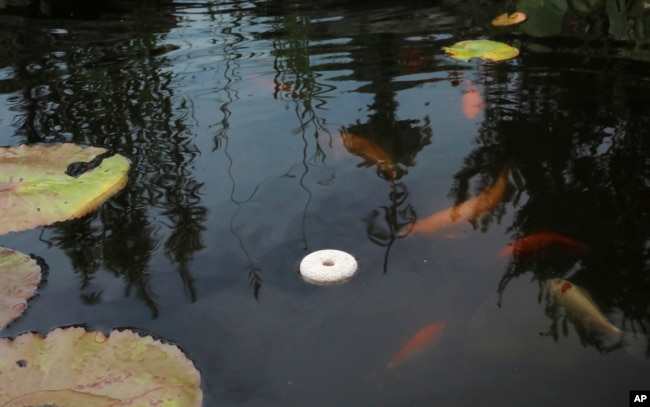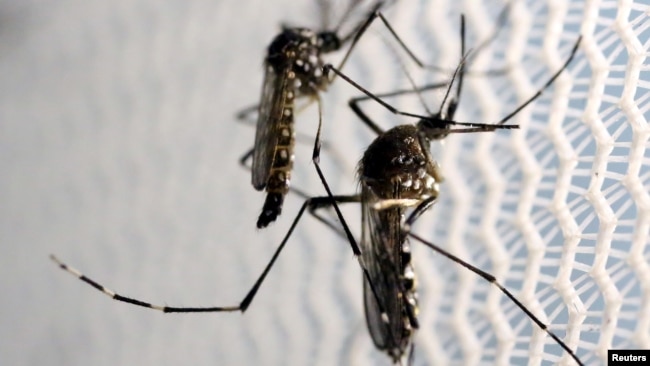その存在意義を感じられない人間にとっては天敵の”Mosquitoew"!!
若い人と一緒にいても、なぜか刺されてしまい、血管に沿って痒みが広がるので、大キライです!!
さて、そのにっくき蚊を駆除できる方法を学びましょう。
そして、VOAで英語を学びましょう!!
蚊を減らす方法(和訳)
How to Cut Down on Mosquitoes
August 22, 2022
屋外で過ごす人なら、誰もが経験したことのある蚊。この吸血昆虫は、かゆみを伴う刺し傷を与え、病気を蔓延させる可能性があります。
蚊は、西ナイル、ジカ熱、デング熱、マラリアなどのウイルスを蔓延させる可能性があります。世界保健機関の2021年の報告書によると、2020年には世界中で2億4100万人のマラリア患者と62万7000人のマラリアによる死亡者が発生すると推定されています。
しかし、蚊を減らすために人々ができることがあります。蚊が繁殖しにくくすることができます。そして、自分自身を守ることもできるのです。
ジェシカ・ダミアーノさんはガーデニングの専門家です。AP通信にアウトドアライフについて寄稿しています。最近の記事で、ダミアーノさんは、最善の対策は予防であると述べています。その記事の中で、彼女はあなたの住んでいる場所で蚊の数を減らす方法を提案しています。
蚊を避けるのは難しいように思われるかもしれません。世界には、蚊が密集している地域があります。水辺に住んでいる人は、より多くの蚊に遭遇するかもしれません。しかし、蚊の数を減らすためにできる対策がいくつかあります。
蚊が卵を産むのに必要な水深は1cm未満です。メスは一度に数百個の卵を産むことができます。ですから、敷地内に水が溜まっていないかどうかチェックしてください。子供のおもちゃ、ゴミ箱のふた、調理用の鍋など、小さな容器に水がたまりやすくなっています。
たとえ少量であっても、水が溜まっていたら取り除きましょう。不要な水が溜まっている容器の底に穴をあけます。
池や鳥の水槽など、その他の水源は、化学物質で処理することができます。
ダミアーノさんは、Bacillus thuringiensis israelensis(バチルス・チューリンゲンシス イスラエレンシス)、略してBtiと呼ばれる細菌を提案します。この細菌は、蚊の幼虫を殺すのに安全で効果的な方法です。Btiは何種類かあります。それぞれターゲットとする昆虫が異なります。ですから、必ず蚊をターゲットにしたものを購入してください。
Bti はまた、”Mosquito Dunks”と呼ばれるリング状の製品など、いくつかの形態で提供されます。これらのリングは水に浮き、保護の30日間を提供しています。米国疾病対策予防センターの専門家は、モスキートダンクは”..人やペットなどの動物、ミツバチを含む他の昆虫に害を与えることはない”と述べています。
また、自分で蚊取り器を作ることもできます。水を張った暗い色の容器に、一握りのわらや干し草、草の切りくずを入れます。それを1~2日置いておきます。その後、モスキートダンクを1本入れます。
蚊がたくさんいる場合は、周辺にいくつかの容器を置いてください。分解された有機物が虫を引き寄せます。処理した水の上に卵を産み付けます。30日ごとに水を取り替え、新しい薬剤を加えて、将来の蚊の発生を阻止してください。
また、蚊は生い茂った植物を好みます。庭の整理整頓を心がけましょう。植物はあまり高くならないようにしましょう。
扇風機を高速で回すと、蚊の活動を抑えることができます。虫を吹き飛ばすだけで、効果があるのです。また、私たちが息を吐くたびに、息から出る二酸化炭素が蚊を引き寄せます。扇風機は、私たちの二酸化炭素を素早く取り除くのに役立ちます。
ダミアーノさんは、化学毒薬のスプレーを避けるよう勧めています。化学薬品は有用な昆虫を脅かす可能性があります。これらの化学薬品は、蚊の成虫のごく一部しか防げない、と彼女は警告しています。また、殺虫剤を効果的に使うには、1シーズンに数回使用する必要があるそうです。
ダミアーノさんによれば、いわゆる”モスキートプランツ”と呼ばれるものには、蚊を撃退するオイルや化学物質が含まれているといいます。しかし、その植物は、通常、葉をつぶすことによってそれらの化学物質が放出されない限り、蚊を遠ざけることはできないのです。そのような植物を身近に置いておくだけでは、何の役にも立ちません。
シトロネラやレモングラスのオイルで、ある程度防げるかもしれないという研究もいます。しかし、ダミアーノさんは、これはまだ証明されていないと考えています。単に人間の匂いを隠すだけかもしれません。
自分の身を守るためにできることは他にもあります。ドアや窓には網戸をつけるか、閉めておくことです。長袖の服を着る。そして、夕方から朝方にかけての屋外での活動時間を減らすことです。蚊はその時間帯に最も活発に活動します。
蚊はすべてす悪いのですか?
蚊を退治するために、蚊には何か目的があるのだろうかと自問することがあります。蚊は受粉媒介者であり、植物の繁殖を助けます。そして、鳥やコウモリなどの動物の餌にもなります。また、魚や亀の中には蚊の幼虫を食べるものもあります。しかし、ダミアーノさんは、あなたが住んでいるところで蚊を駆除しても、環境に害を与えることはないと言っています。
How to Cut Down on Mosquitoes
Almost everyone who spends time outdoors has experienced mosquitoes. These bloodsucking insects give itchy bites and can spread disease.
Mosquitoes can spread viruses like West Nile, Zika, dengue and malaria. A 2021 report from the World Health Organization estimated that in 2020 there were 241 million malaria cases and 627,000 malaria deaths worldwide.
But there are things people can do to cut down on mosquitoes. You can make it harder for them to reproduce. And you can protect yourself.
Jessica Damiano is a gardening expert. She writes about outdoor living for the Associated Press. In a recent story, Damiano said the best control is prevention. In that story, she gave suggestions on how to cut mosquito populations where you live.
It may seem difficult to avoid mosquitoes. Some areas of the world are densely populated with them. People who live near bodies of water may experience more mosquitoes. But there are several measures you can take to reduce their numbers.
Mosquitoes need less than a centimeter of water to lay eggs. A female can lay hundreds of eggs at a time. So, check your property for standing water. Water can easily collect in small containers – a child’s toy, a trash can lid, or a cooking pot.
Get rid of standing water, even if the amount seems small. Make holes in the bottoms of containers that can hold unwanted water.
Other sources of water such as in ponds and bird baths can be treated with chemicals.
Damiano suggests a bacterium called Bacillus thuringiensis israelensis or Bti for short. The bacterium is a safe and effective way to kill mosquito larvae. Several kinds of Bti are available. Each target different insects. So be sure to buy the one to target mosquitoes.
Bti also comes in several forms, including ring-shaped products called “Mosquito Dunks.” These rings float in water and offer 30 days of protection. Experts at the U.S. Centers for Disease Control and Prevention say mosquito dunks “…will not harm people, pets and other animals,” and other insects, including honeybees.
You also can make your own mosquito trap. Put a handful of straw, hay, or grass cuttings into a dark-colored container filled with water. Let it sit for one to two days. Then add one mosquito dunk.
If you have many mosquitoes, place several containers around the area. Decomposing organic matter will attract the insects. They will lay eggs on the treated water. Every 30 days, change the water and add new chemicals to stop future generations of mosquitoes.
Mosquitoes also like overgrown plants. Keep your yard organized. Do not let plants grow too tall.
Running a fan at high speed will reduce mosquito activity. It works by simply blowing the insects away. Also, every time we breathe out, carbon dioxide from our breath attracts mosquitos. A fan can help get rid of our carbon dioxide quickly.
Damiano suggests avoiding chemical poison sprays. These can threaten helpful insects. These chemicals, she warns, only control a small part of the adult mosquito population. Also, she said, insect poisons need to be used several times in a season to work effectively.
Damiano says that so-called “mosquito plants” sold as mosquito repellents contain oils or chemicals that repel mosquitoes. But the plants do not keep mosquitoes away unless those chemical compounds are released, usually by crushing the leaves. Just having such a plant around will not help.
Some studies claim that citronella and lemongrass oil may provide some protection. But Damiano thinks this has not yet been proven. They may simply hide human scent.
There are other things you can do to protect yourself. Put screens in your doors and windows or keep them closed. Wear long clothing. And cut down on time spent outdoors between the early evening and the early morning. Mosquitoes are most active during that time.
Are mosquitoes all bad?
On the hunt to kill mosquitoes, you may ask yourself if they serve some purpose. Mosquitoes are pollinators, meaning they help some plants reproduce. And they are food for some animals, especially birds and bats. Also, some fish and turtles eat mosquito larvae. But Damiano says that getting rid of mosquitoes where you live will not harm the environment.
Words in This Story
itchy – adj. a feeling of wanting to scratch or rub skin because of an unpleasant feeling on it
larvae – n. a young wingless form (as a grub or caterpillar) of many insects that hatches from an egg
decompose –v. the natural process of slowly breaking down into simpler materials
attract –v. to cause something to come to a place
spray – n. liquid that is forced out from a container to cover a small area
repellent – n. a substance used to keep something away
screen – n. a woven material that is held together by wood or metal on the sides which is placed in windows to prevent insects from entering
pollinator – n. an animal, often an insect, that spreads pollen from plant to plant permitting plants to produce seeds

